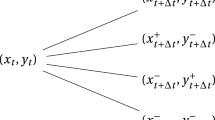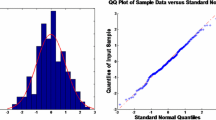Abstract
In this paper, we consider a novel approach for the fair valuation of a participating life insurance policy when the dynamics of the reference portfolio underlying the policy are governed by an Asymmetric Power GARCH (APGARCH) model with innovations having a general parametric distribution. The APGARCH model provides a flexible way to incorporate the effect of conditional heteroscedasticity or time-varying conditional volatility and nests a number of important symmetric or asymmetric ARCH-type models in the literature. It also provides a flexible way to capture both the memory effect of the conditional volatility and the asymmetric effects of past positive and negative returns on the current conditional volatility, called the leverage effect. The key valuation tool here is the conditional Esscher transform of Bühlmann et al. (1996, 1998). The conditional Esscher transform provides a convenient and flexible way for the fair valuation under different specifications of the conditional heteroscedastic models. We illustrate the practical implementation of the model using the S&P 500 index as a proxy for the reference portfolio. We also conduct sensitivity analysis of the fair value of the policy with respect to the parameters in the APGARCH model to document the impacts of different conditional volatility models nested in the APGARCH model and the leverage effect on the fair value. The results of the analysis reveal that the memory effect of the conditional volatility has more significant impact on the fair value of the policy than the leverage effect.
Similar content being viewed by others
References
Bacinello A.R. (2001). Fair pricing of life insurance participating policies with a minimum interest rate guaranteed. ASTIN Bulletin 31(2): 275–297
Bacinello A.R. (2003). Fair valuation of a guaranteed life insurance participating contract embedding a surrender option. Journal of Risk and Insurance, 70(3): 461–487
Back K., Pliska S.R. (1991). On the fundamental theorem of asset pricing with an infinite state space. Journal of Mathematical Economics 20, 1–18
Black, F. (1976). Studies of stock market volatility changes. In: Proceedings of the American Statistical Association, Business and Economic Statistics Section, (pp. 177–181).
Bollerslev T. (1986). Generalized autoregressive conditional heteroscedasticity. Journal of Econometrics 31, 307–327
Boyle P.P., Schwartz E.S. (1977). Equilibrium prices of guarantees under equity-linked contracts. Journal of Risk and Insurance 44, 639–660
Brennan M.J., Schwartz E.S. (1976). The pricing of equity-linked life insurance policies with an asset value guarantee. Journal of Financial Economics 3, 195–213
Brennan M.J., Schwartz E.S. (1979). Alternative investment strategies for the issuers of equity-linked life insurance with an asset value guarantee. Journal of Business 52, 63–93
Bühlmann H., Delbaen F., Embrechts P., Shiryaev A.N. (1996). No-arbitrage, change of measure and conditional Esscher transforms. CWI Quarterly 9(4): 291–317
Bühlmann H., Delbaen F., Embrechts P., Shiryaev A.N. (1998). On Esscher transforms in discrete finance models. ASTIN Bulletin 28(2): 171–186
Chu C.C., Kwok Y.K. (2006). Pricing participating policies with rate guarantees and bonuses. International Journal of Theoretical and Applied Finance 9(4): 517–532
Delbaen F., Schachermayer W. (1994). A general version of fundamental theorem of asset pricing. Mathematische Annalen 300, 463–520
Ding Z., Granger C.W.J., Engle R.F. (1993). A long memory property of stock market returns and a new model. Journal of Empirical Finance 1, 83–106
Dybyig P.H., Ross S.A. (1987). Arbitrage. In: Milgate M., Eatwell J., Newman P.(eds) The new palgrave: A dictionary of economics. McMillan, United States
Engle R.F. (1982). Autoregressive conditional heteroscedasticity with estimates of the variance of U.K. inflation. Econometrica 50, 987–1008
Engle R.F., Ng V.K. (1993). Measuring and testing the impact of news on volatility. Journal of Finance 48, 1749–1778
Esscher F. (1932). On the probability function in the collective theory of risk. Skandinavisk Aktuarietidskrift 15, 175–195
Fan J., Yao Q. (2003). Nonlinear time series: Nonparametric and parametric models. Springer-Verlag, New York
French K.R., Schwert G.W., Stambaugh R.F. (1987). Expected stock returns and volatility. Journal of Financial Economics 19, 3–29
Gerber H.U., Shiu E.S.W. (1994). Option pricing by Esscher transforms (with discussions). Transactions of the Society of Actuaries 46, 99–191
Geweke J. (1986). Modeling the persistence of conditional variances: a comment. Econometric Review 5, 57–61
Glosten L.R., Jagannathan R., Runkle D.E. (1993). On the relationship between the expected value of the volatility of the nominal excess return on stocks. Journal of Finance 48(5): 1779–1801
Granger C.W.J., Ding Z. (1995). Some properties of absolute return: an alternative measure of risk. Annales dÉconomie et de statistique 40, 67–91
Grosen A., Jørgensen P.L. (2000). Fair valuation of life insurance liabilities: The impact of interest rate guarantees, surrender options, and bonus policies. Insurance: Mathematics and Economics 26, 37–57
Grosen A., Jørgensen P.L. (2002). Life insurance liabilities at market value: an analysis of insolvency risk, bonus policy, and regulatory intervention rules in a barrier option framework. Journal of Risk and Insurance 69(1): 63–91
Harrison J.M., Kreps D.M. (1979). Martingales and arbitrage in multi-period securities markets. Journal of Economic Theory 20, 381–408
Harrison J.M., Pliska S.R. (1981). Martingales and stochastic integrals in the theory of continuous trading. Stochastic Processes and Their Applications 11, 215–280
Harrison J.M., Pliska S.R. (1983). A stochastic calculus model of continuous trading: Complete markets. Stochastic Processes and Their Applications 15, 313–316
He, C., & Terasvirta, T. (1999a). Higher-order dependence in the general power ARCH process and a special case. Stockholm School of Economics, Working Paper Series in Economics and Finance, No. 315.
He C., Terasvirta T. (1999b). Statistical properties of the asymmetric power ARCH process. In: Engle R.F., White H. (eds) Cointegration, causality, and forecasting. Festschrift in honor of C. W. J. Granger. Oxford University Press, Oxford
Higgin M., Bera A. (1992). A class of nonlinear ARCH models. International Economic Review 33, 137–158
Laurent S. (2004). Analytical deviates of the APARCH model. Computational Economics 24, 51–57
Nelson D.B. (1991). Conditional heteroscedasticity in asset returns. Econometrica 59, 347–370
Pagan A.R., Schwert W. (1990). Alternative models for conditional stock volatility. Journal of Econometrics 45, 267–290
Pentula S. (1986). Modeling the persistence of conditional variances: A comment. Econometric Review 5, 71–74
Priel D., Putyatin V., Nassar T. (2001). On pricing and reserving with-profits life insurance contracts. Applied Mathematical Finance 8, 145–166
Schachermayer W. (1992). A Hilbert space proof of the fundamental theorem of asset pricing in finite discrete time. Insurance: Mathematics and Economics 11, 249–257
Schwert W. (1990). Stock volatility and the crash of ’87. Review of Financial Studies 3, 77–102
Siu T.K. (2005). Fair valuation of participating policies with surrender options and regime switching. Insurance: Mathematics and Economics 37(3): 533–552
Siu T.K., Tong H., Yang H. (2004). On pricing derivatives under GARCH models: A dynamic Gerber-Shiu’s approach. North American Actuarial Journal 8(3): 17–31
Taylor S.J. (1986). Modeling financial time series. John Wiley & Sons, New York
Zakoian J.M. (1994). Threshold heteroscedasticity model. Journal of Economic Dynamics and Control 15, 931–995
Author information
Authors and Affiliations
Corresponding author
Rights and permissions
About this article
Cite this article
Siu, T.K., Lau, J.W. & Yang, H. On Valuing Participating Life Insurance Contracts with Conditional Heteroscedasticity. Asia-Pacific Finan Markets 14, 255–275 (2007). https://doi.org/10.1007/s10690-007-9062-9
Received:
Accepted:
Published:
Issue Date:
DOI: https://doi.org/10.1007/s10690-007-9062-9




